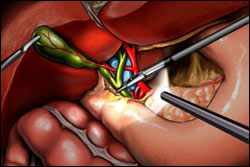- No products in the cart.
Institute Of
Gastroenterology
Home » The Institute of Gastroenterology, Hepatobiliary Science & Transplantation » Surgical Gastroenterology » Gallbladder and Biliary Tract Surgery
Gallbladder and Biliary Tract Surgery
Gallbladder stones are a very common and usually asymptomatic condition. Some patients have biliary colic, intermittent and often severe pain in the epigastrium or right upper quadrant and sometimes between the scapula due to temporary obstruction of the cystic duct by a gallstone. If the cystic duct impediment persists, the gallbladder becomes inflamed and the patient develops cholecystitis, an acute inflammation and infection of the gallbladder. The vast majority of gallstone patients are asymptomatic.

Some common ailments of gallbladder and bile duct are as follows:
- Gallstones are shaped once digestive fluid salts become laborious, causing constipation.
- Cholecystitis is an acute and chronic inflammation.
- Acute cholecystitis might be the result of tumors and different illnesses.
- Chronic cholecystitis is caused because of shrinkage of the gallbladder due to continual acute cholecystitis and loses its functionality.
- Choledocholithiasis occurs when the gallstones are lodged in the bile ducts or the neck of the gallbladder.
- Acalculous gallbladder malady is additionally referred to as biliary kinesia that occurs due to the absence of gallstones.
- Primary Sclerosing cholangitis is scarring, inflammation and injury to the bile ducts.
- Gallbladder cancer spreads to other organs from the inner walls of the gallbladder.
- Gallbladder polyps are innocent growths or lesions at the gallbladder..
- Gangrene of the gallbladder occurs when there is inappropriate or inadequate blood waft and the gallbladder does not function.
- Abscess of the gallbladder occurs when the area has pus formation and is inflamed.
- Bile duct obstruction is blockage of bile ducts due to gallstones.
Surgical options
Laparoscopic cholecystectomy : In this procedure the gallbladder is removed by minimally invasive surgical techniques. The procedure is done under general anesthesia. Four tiny slit are made in and around the umbilicus, which are called laparoscopic ports. Thin, long tubes or laparoscopes are inserted through these slit which magnifies the view of the area. Surgical instruments are used to cautiously separate the gallbladder from the liver and the bile duct and extract it via one of the ports.
Laparoscopic common bile duct exploration: This procedure is widely used in the treatment of choledocholithiasis and can be done percutaneously, laparoscopically or endoscopically.The approach is the same as laparoscopic cholecystectomy. Four ports are opened and a awfully small gap is formed within the cystic duct where the gallbladder connects to the bile duct. Cholangiography is performed through the insertion of a thin tube. A balloon or small basket is used to retrieve the stones out of the canal.
Laparoscopic bile duct bypass: The outflow of bile into the intestines is blocked due to a stricture of the bile duct. Then the bile builds up in the blood and causes jaundice. Bile duct surgeries are very complex and difficult. Since the bile duct is located deep into the abdomen, the process carries longer incisions into the abdomen. Laparoscopy is used to remove the stones in the bile duct.
Resection of choledochal cysts: There are five types of choledochal cysts that can be treated through different techniques.
- Type 1: They are saccular or fusiform dilatations of the extrahepatic duct and a complete excision of the extrahepatic duct is performed. Biliary-enteric continuity is restored with a Rouxen-Y hepatic hepaticojujenostomy.
- Type 2: It is an isolated diverticulum that protrudes from the wall of the common bile duct, completely removing the dilated diverticulum and occluding the common bile duct with a T-tube.
- Type 3: Called the choledochocele it develops from the intraduodenal portion of the regular bile duct and therapeutic choice commanly depends on the size of the cyst. Endoscopic sphinterectomy is used for choledochoceles < 3 cm and lesions > 3 cm are extracted via a transduodenal approach.
- Type 4: In the cyst there are several dilatations of the intrahepatic and extrahepatic biliary tract. A Roux-en-Y hepaticojujenostomy is done to completely excise the extrahepatic duct. In intrahepatic ductal diseases, the affected lobe of the liver is resected.
- Type 5: This is called Caroli's disease and it includes multiple dilatations of the intrahepatic canal and the left lobe. A liver transplant may be required if there are signs of liver impairment.


